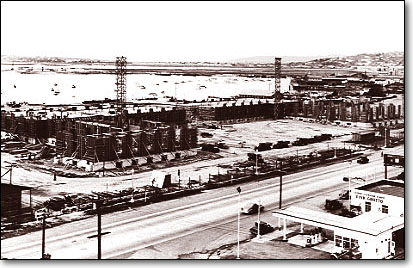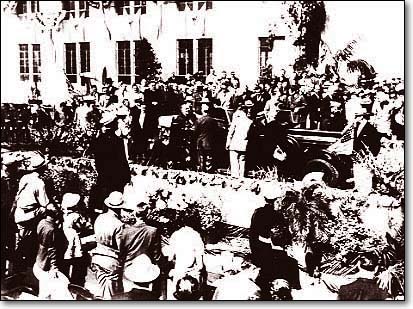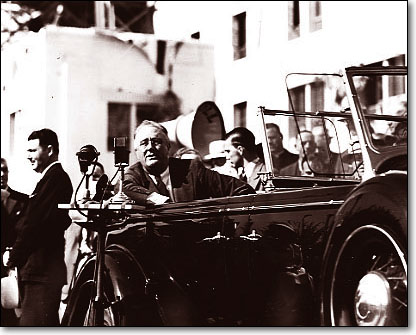The
Design

A modified Spanish Colonial style
with ornamentation of gold and silver azure tiles was chosen as the
final design of the Civic Center. Head architect Samuel Hamill
claimed that the initial inspiration for the blueprints came from
the Nebraska State Capitol. The four Civic Center architects gave
the Civic Center its' Spanish Colonial foundation but several
details are Southwestern in style. Southwestern details include: a
red Mission tile roof, glazed Franciscan inlaid pottery tile, and
arched door and window openings.
The exterior of the of the building is
a vast display of intricacy, as well as a visible tribute to San
Diego government. Four large governmental emblems on the steps of
the Civic Center incorporate shields with various detailed designs.
The ten-foot tower rising above the entrance is faced with
decorative tile, as are the arches above the doors. The central
panel over the main entrance was intended to represent the history
of San Diego, beginning with the date of discovery and working
upward to a fish, a naval vessel, the California tower, and an
airplane bearing the date of construction. Central to all designs is
the shield of the federal government and the inscriptions that grace
the entrances; the west side exhibits a quote by Virgil. "The
Noblest Motive is the Public Good", and the east side reads "Good
Government Demands the Intelligent Interest of every Citizen".

The Construction

The ground breaking ceremony was
commenced at the site on the morning of December 5, 1935. George W.
Marston was chosen to turn the first earth with a golden shovel.
About 200 people, including city, county, state, and federal
officials observed the ceremonies at the waterfront site. For many
of these people, this ceremony symbolized the efforts that had been
expended for decades. After the ground breaking, the land was left
for nearly a month, until January 4, 1936, when actual construction
began.
The demand for safety overrode
economic concerns in virtually every aspect of construction. It was
decided that steel pilings, rather that wood pilings, would be used
to prevent shearing in the event of an earthquake. Due to its'
concern for safety, the Civic Center received substantial
recognition for its' construction. It was considered to be on the
cutting edge of engineering development. The Civic Center project
was virtually making engineering history for using steel piling to
bear lateral stresses for the first time in the history of
construction. The foundation and frame were built with reinforced
concrete; the building itself was constructed in five separate
sections. The gaps between the various sections were closed with
metal accordion and slip joints so that each section could move
independently in the event of an earthquake.
Construction was complete when the last phase of the project was
finished ninety days ahead of schedule by contractor Charles
Hoskins. The total cost of the new San Diego City and County
Administration Building was $1,730,474, and over 300 men were given
employment as a result of the WPA Civic Center project.
 |
The Background
Prior to the completion of the
San Diego Civic Center in 1938, offices of the City and
County Administration Departments had been spread throughout
downtown San Diego.
In 1902, a building to house
these offices was suggested by civic leaders. Five years
later a Civic Center Committee was formed and became one of
the most effective vehicles for obtaining public support for
the project. The first president of the committee, George
White Marston, introduced an eminent city planner, John
Nolan, to the project. Nolan published his first evaluation
of the city in 1908. His work provided the base for numerous
waterfront development proposals and also provided the
framework that initiated civic center construction.

The Vision
In 1913 a civic center plan
based on the one presented by John Nolan was put before the
city council. This plan was different in that, it shifted
the site to the east in order to reduce cost. Regardless of
the reduced cost, city officials refused of give any plan
consideration until the economic situation in San Diego
became more secure. No definite action took place before the
outbreak of World War I; the war diverted the public's
attention until 1923, when John Nolan began to work on his
second city plan. The plan was submitted to the City
Planning Commission in 1926. This plan recommended the
waterfront location and in 1927 the site was approved
through a county wide election. There were many objections
regarding the waterfront location and other proposed
locations were put forth for consideration. Other sites
included the Courthouse site at Broadway and "C" street and
the Balboa Park site at Date Street and Sixth Avenue. The
waterfront site won final approval by the Board of
Supervisors as well as the citizens in December of 1933.

The Funding
The first payment in the resurrection of the
civic center was for the waterfront property. In 1933, the
city and the county made the purchase for one thousand
dollars. In June of that same year, the City Attorney
informed the city and county that there were not enough
funds available to erect the building. It was advised that
an application be made to the Federal Emergency Public Works
Fund. In 1934, the city and county appropriated funds to be
used to pay for architectural plans. At this point, three
architects were chosen to work on the plans: Sam Hamill,
Richard Requa and William Johnson. These men presented the
first model of the civic center to the Board of Supervisors
in January 1935. That same month, the administrator of the
Federal Emergency Public Works informed the city and county
that federal funds were depleted and encouraged San Diego to
continue applying for assistance in the event that more
funding would become available. In April, the county council
resolved to construct the Civic Center at a total cost of
one million dollars and proceeded to apply for federal aid
through the Public Works Administration. President Roosevelt
approved the grant in September, one week after a personal
tour of the site. The federal contribution, consisting of
$989,528, was in the bank of San Francisco by December.
The Dedication

On July 16, 1938, Roosevelt
traveled by train to Los Angeles and then boarded an
automobile at the head of a twenty-five car caravan bound
for San Diego. President Roosevelt arrived at the dedication
site around three in the afternoon before a crowd estimated
at 25,000. He gave a short speech in which he remarked about
the engraved quote above the building's west entrance, "I
would like to say that I like especially the sentiment
expressed on the face of [the portal], ‘The noblest motive
is the public good.' I think if we all carry that motto in
our hearts, in every city and community in the land, there
is no question but the proper thing, American democracy,
will survive."
The dedication ceremony took place five months prior to
completion of the building, which was celebrated by opening
ceremonies on December 23, 1938.

The City
Relocation

During the 1950s, a growing
awareness regarding the need for more offices space led to
big changes for the Civic Center. A report prepared by the
Joint Committee on City-County Office Space declared that
the Civic Center was too small. It recommended that the City
move to another location. The County Chief agreed with the
recommendation, adding that the city's needs were more
immediate than the county's needs. In 1963 the City and
County entered into an agreement to transfer the city's
portion of the property to the county.
To complete the
transaction, a legislative grant was written in 1961, and
all documents were prepared, reviewed and approved by the
staffs of the city and the county. The original appraisal of
seven million dollars was lowered to an actual price of $3.3
million. The signing of the agreement took place on July 17,
1963. After the City offices moved out of the Civic Center,
the structure was officially renamed "San Diego County
Administration Center" and a new sign was mounted over the
old inscribed letters above the east entrance.
The Expansion
Several changes were made to
the building from the time it first became occupied. In 1958
the Health Center was constructed on the northwest corner of
the site in an attempt to incorporate elements of the Civic
Center's architecture. Also, during that year, an addition
was made to the north wing to hold the Board of Supervisor's
offices.
The Civic Center was
constructed so that the wings could support the weight of an
additional floor, if the need for such space arose. In 1960
a third floor expansion was made to the south wing in order
to accommodate the mayor's offices as he moved down from
eighth floor of the tower. In 1978 the top floors were
declared a fire hazard because there was only one stairwell,
the tower occupants were forced to move down to the main
part of the building.
After the city's departure
from the building, expansion slowed down. However, in 1974,
the largest expansion ever to take place on the building
since its construction was proposed; a 21,000 square foot
addition. There were third and fourth floor additions and
remodeling; southeast and southwest wings were added to the
third floor, to match the architecture on the north side;
and a cafeteria was constructed on the south end of the
fourth floor; office interiors were modernized, lighting was
updated and ventilation was improved. These changes were
complete in 1982.
After expansions had been made to the fullest extent that
the building could support, County Administration continued
to relocate to other parts of the county.

The Historical
Designation
During the 1980's an idea was
conceived to open up CAC bland for commercial leasing. The
County Board of Supervisors decided to look into the
possibilities of allowing hotels to be built upon the nine
acres of parking lots that surround the County
Administration Center. Spurred by this proposal as well as
others such as, tearing down the CAC to build a bigger and
more utilitarian edifice, a group of 400 locals came
together. This group was known as Citizens Coordinate for
Century 3, dedicated themselves to the preservation of the
County Administration Center. The goal was to obtain
National Historical Site status for the complex. Citizens
Coordinate for Century 3 researched the history of the
building and produced a nomination form to be sent to the
National Register of Historic Places. While awaiting the
federal response, the City Historic Site Board approved the
CAC as a historic site on October 22, 1986. Finally, on May
16, 1988, the site received recognition on the national
register. On July 11,1988, the Board of Supervisors and
Citizens Coordinate for Century 3 celebrated the 50th
anniversary of the original dedication of the building by
president Roosevelt as well as a celebration of the site's
placement on the National Register of Historic Places. As
part of the ceremony, President Roosevelt's eldest son,
James Roosevelt came and spoke, just as his father did, on
the steps of the CAC. |